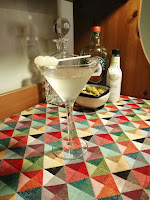Cocktail Magic
Q.: I've been making cocktails at home for a while and I think I'm pretty good at it. When I go to a cocktail bar, though, the drinks I'm served seem to have that extra bit of magic that I don't achieve at home. I follow the recipes carefully but don't seem to get the same results. Where am I going wrong?
A.: The first thing to say is that you're not going wrong. By following those well-known recipes, you can be sure of consistent results, and if you and your guests enjoy them, you're doing everything right. I'm guessing from your question, though, that you're aiming to make, not just good cocktails, but great ones. That's where things get tricky. You see, cocktail waiters are notoriously individualistic in their work. They all want to make the greatest Martini there ever was, the most interesting Negroni or the subtlest Alexander. To achieve this, they have to stray from the classic recipes and bring in elements from elsewhere. The most common way they do this is by using different cocktail bitters.
Bitters are an essential part of cocktail-making. They are made from aromatic spices and other plant extracts, in alcohol, and are used in very small quantities. The most famous is Angostura, famous for giving the pink gin its characteristic spicy aroma and burnt-orange hue. Since the cocktail boom of the 2000s, many varieties of bitters have become widely available, including new ones and some reviving old recipes.
 |
| Pink Gin: the officers' favourite |
The taste of mint is surprisingly sympathetic to citrus fruit, and you can use it to bring its characteristic freshness to all manner of drinks. Just one dash will give a White Lady quite a lift - perfect for summer garden parties. It will bring that same cool breath to a Greyhound or Salty Dog and is a startlingly good addition to an Old Fashioned in the summer.
One of my favourite cocktails is the Gibson, a dry Martini garnished with silverskin onions. Some bar tenders add a little of the liquor from the onion jar, but this is a little harsh to my taste. That savoury element is best provided, I think, by adding a couple of dashes of celery bitters. It's not enough to make the drink taste of celery but it adds a certain "something" that would be lacking otherwise. It's a great ingredient for giving a Bloody Mary more umami, and will lift your Dirty Martini to another level. While we're on Martinis, did you know that a dash of orange bitters was considered essential to a Dry Martini until about the 1960s? Try it with and without, and decide which you prefer.You may be wondering where these apparently rare ingredients come from. A quick search of the independent liquor shops, or on your favourite online shopping site, will throw open a whole world of flavours you've never considered. Lavender bitters might grace one person's Martinis: another might want to try black pepper bitters in their Manhattan. Lime bitters might give a Grasshopper the kind of bounce one drinker enjoys: chilli bitters might wake up another's Margaritas. Play around and have fun. The only rule is to keep it light. The flavour of bitters is meant to be a subtle twist on the well-loved classic, not the death of it.Oh, and never give away the secret of your "magic."








Comments
Post a Comment